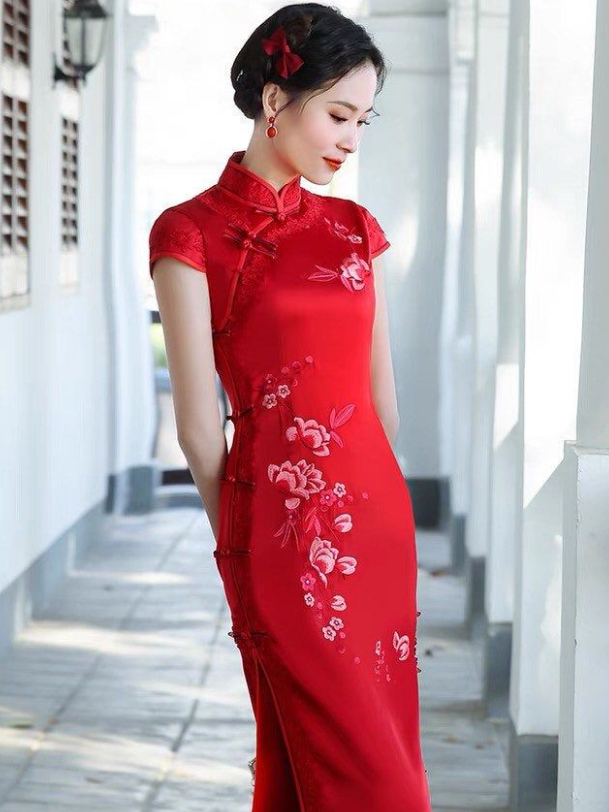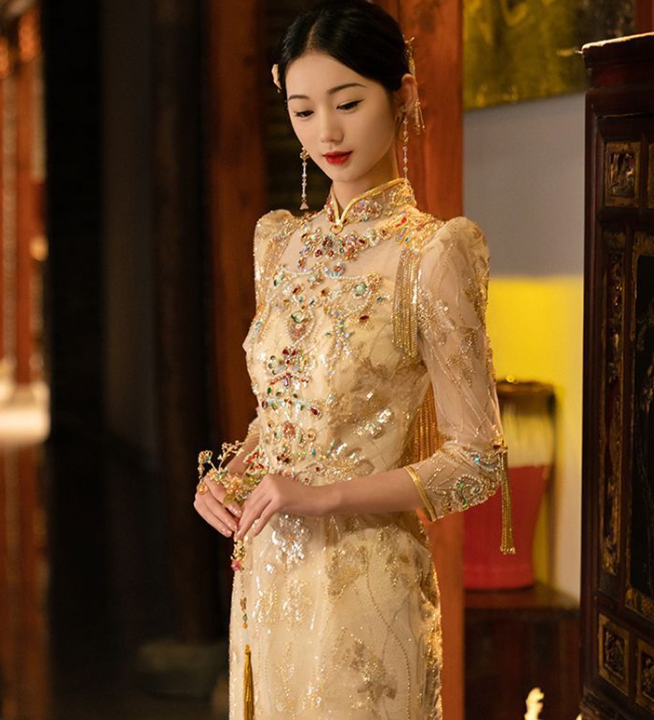Yes, you can, but ensure it’s appropriate and respectful to the event’s cultural context.
Types of Chinese Dresses
China, with its rich history and diverse regions, has given birth to a variety of traditional dresses. Here’s an in-depth look at some of the most iconic styles:

The Qipao (Cheongsam)
The Qipao, also known as the Cheongsam, is a tight-fitting dress that originated from the Manchu ethnic group in China. Over the years, it has evolved and is now recognized as one of the country’s most iconic traditional outfits.
- Design: Modern Qipao often features a high neckline, a fitted waist, and side slits that reach the thigh. It can be both knee-length or longer.
- Material: Traditionally made of silk, but can also be found in materials like satin and velvet in modern versions.
- Occasions: Suitable for various events, from daily wear to formal occasions like weddings and banquets.
- Variations: The design of the Qipao has undergone various changes over the years. From sleeve lengths (long, short, or sleeveless) to embroidery detailing and collar designs.
The Hanfu
Hanfu is a term used to describe the historical dress of the Han Chinese people. The design and style of Hanfu have evolved over centuries, reflecting China’s dynastic history.
- Design: Hanfu generally consists of a robe or a jacket worn over a skirt or trousers. Styles and cuts can vary based on the dynasty they represent, such as Tang, Song, or Ming dynasty styles.
- Material: Predominantly made of silk, though cotton and linen variations are also available.
- Occasions: Historically worn daily, but in modern times, it’s often worn during cultural festivals, traditional ceremonies, or by enthusiasts wanting to reconnect with their cultural roots.
- Variations: Hanfu has numerous variations, like the “Ruqun” (a type of gown with a blouse and skirt) or the “Shenyi” (a one-piece robe).
Modern Variations and Adaptations
With globalization and the melding of cultures, traditional Chinese dresses have seen contemporary adaptations, blending Eastern and Western fashion elements.
- Fusion Designs: Modern designers might integrate elements from the Qipao into western-style dresses or vice-versa. For example, a Qipao with a more westernized skirt or a western dress with Mandarin collars.
- Material and Quality: While silk remains a popular choice, designers are also exploring other materials, including eco-friendly options or synthetics for durability.
- Occasions: These fusion designs are often spotted at global red carpet events, fashion shows, and even everyday street style.
- Variations: Contemporary variations might include changes in hemline, incorporation of prints from various cultures, or the addition of modern embellishments like sequins or beads.
Weddings and Traditional Attire
Weddings are a celebration of love, union, and often, cultural heritage. The attire worn during these ceremonies is deeply ingrained in cultural traditions and is an essential part of the festivities. As such, understanding the dos and don’ts, especially when attending a wedding from a different culture, is paramount.
Importance of Dress Code at Weddings
The way one dresses at a wedding is not merely a fashion statement but a sign of respect towards the couple and the culture they represent.
- Setting the Tone: The attire can set the tone for the event. For instance, a formal black-tie event creates an ambiance of sophistication, while a beach wedding attire brings about a casual and relaxed vibe.
- Avoiding Unwanted Attention: Dressing inappropriately can divert attention from the couple. An overly flashy dress or an outfit that’s too casual can make one stand out for the wrong reasons.
- Cost Considerations: Investing in the right attire might come with a price. The average cost of a wedding guest outfit can range from $50 for something simple to upwards of $500 for designer wear.
Cultural Sensitivity and Traditional Outfits
As the world becomes more globalized, there’s a higher likelihood of being invited to a wedding from a different cultural background. It’s here that understanding and respect for traditional outfits become crucial.
- Understanding Symbolism: Many traditional outfits have deep-rooted cultural meanings.
- Avoiding Misappropriation: Wearing traditional outfits without understanding or respect can lead to accusations of cultural appropriation. It’s crucial to wear such attire with a genuine appreciation for its cultural significance.
- Seeking Guidance: If unsure, it’s always best to ask. Reaching out to the couple or their family for guidance on appropriate attire can be a sign of respect.
- Cost and Quality: Traditional outfits can sometimes be expensive due to intricate designs and quality materials.
Pros of Wearing a Chinese Dress to a Wedding
The decision to don a Chinese dress at a wedding, especially if you’re from a different cultural background, is one that can be both aesthetically pleasing and culturally enriching. Let’s delve into the advantages of making such a choice:
Unique Style and Elegance
Chinese dresses, such as the Qipao or Cheongsam, have an innate elegance. Their design exudes a blend of grace, sophistication, and rich history.
- Design Excellence: The slender fit, high necklines, and side slits provide a flattering silhouette to diverse body types.
- Intricate Details: The embroidery, patterns, and beadwork on many Chinese dresses are often handcrafted, showcasing exquisite craftsmanship.
- Variety in Choices: From the fabric choices like silk or satin to the variety of colors and designs, there’s a Chinese dress for every style preference.
Embracing Cultural Diversity
In an increasingly globalized world, demonstrating an appreciation for other cultures can be a powerful gesture.
- Bridging Cultures: By choosing to wear a Chinese dress, one is actively participating in the mingling of traditions and showing respect for another culture.
- Celebrating History: Chinese dresses have evolved over centuries, and wearing one is akin to adorning a piece of Chinese history.
- Promoting Inclusivity: Opting for attire outside of one’s own culture at multicultural weddings encourages a more inclusive environment.
Potential Conversation Starter
At social events like weddings, attire can play a pivotal role in sparking conversations.
- Stand Out in the Crowd: The distinct look of a Chinese dress amidst more conventional Western wedding attire can make one stand out.
- Sharing and Learning: It provides an opportunity to share knowledge about the dress, its origins, and its significance. Simultaneously, it can be a learning experience, hearing perspectives from others familiar with the culture or equally curious.
- Building Connections: Shared discussions about cultural appreciation can lead to deeper, more meaningful interactions with fellow guests.

Tips for Wearing a Chinese Dress to a Wedding
Opting for a Chinese dress for a wedding is a bold and beautiful choice. However, to ensure that you strike the right note and respect the attire’s cultural significance, consider the following tips:
Selecting the Right Dress for the Occasion
The suitability of a Chinese dress varies based on the wedding’s theme, venue, and cultural context.
- Understand the Dress Code: For formal weddings, a silk Qipao with delicate embroidery could be a perfect choice. For more casual affairs, perhaps a simpler design or a shorter version might be apt.
- Choose the Right Fit: The beauty of a Qipao or Cheongsam lies in its tailored fit. Ensure that it’s neither too tight nor too loose. Some boutiques even offer custom tailoring to achieve that perfect fit.
- Color Matters: Traditionally, red is considered auspicious in Chinese culture. However, it’s essential to be aware of the wedding’s color theme or any color restrictions to avoid clashing or overshadowing the bride.
Accessorizing Appropriately
The right accessories can enhance the beauty of the dress and complete the look.
- Footwear: Classic heels usually pair well with the Qipao, accentuating its elegance. If the wedding is outdoors, consider wedges or flats to navigate uneven terrain.
- Jewelry: Keep it subtle. The dress itself is often a statement piece, so opt for understated jewelry. Pearls or jade, both cherished in Chinese culture, can be an apt choice.
- Hair and Makeup: A neat updo or soft waves can complement the high collar of the Qipao. For makeup, consider hues that match the dress, keeping it elegant and not too overpowering.
Being Mindful of Cultural Symbols and Designs
Chinese dresses often contain symbols and designs steeped in meaning.
- Understand the Symbolism: Familiarize yourself with the designs on your dress. For instance, the phoenix symbolizes femininity and grace, while dragons represent power and strength. Wearing a dress with both these symbols might indicate marital harmony in Chinese culture.
- Ask and Research: If in doubt, it’s always best to consult someone familiar with Chinese traditions or do some research to ensure that the dress’s designs are wedding-appropriate.







